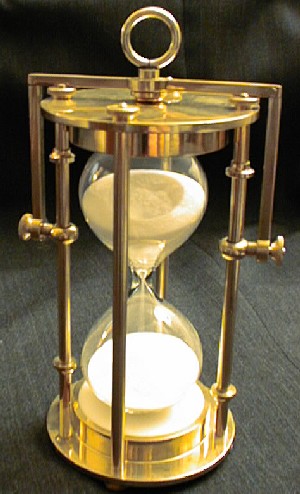The Hourglass
Today, let's look at the hourglass. The University of Houston's College of Engineering presents this series about the machines that make our civilization run, and the people whose ingenuity created them.
We've said a lot about mechanical clocks in this series. Well, the time has come to consider the clock's antithesis, the hourglass. First, how old do you suppose the hourglass is: two thousand years? Four thousand years? Engineer/historian Robert Balmer goes looking for the answer. He finds no evidence of the hourglass until the early 1300s. Oddly enough, it came into use at almost exactly the same time as the first mechanical clocks. The hourglass is only about seven hundred years old.
Of course the hourglass is kin to the water clock. Both depend on a medium flowing out through a hole. But the hourglass has its own technological personality. On the positive side, it's far simpler and cheaper than the mechanical clock or the earlier water clock. Resetting it after it runs down couldn't be simpler. It doesn't vanish the way a graduated candle does. Its accuracy isn't bad once you solve some problems. You can't load just any old sand into it. You have to find a free-flowing material that doesn't absorb water on a humid day and clog up.
On the downside, an hourglass is a short-term timepiece. The very name says it's hard to make one that runs more than an hour. The other big drawback is that it can't be calibrated. Sand moves downward in jerks. The edge of the sand is uneven. If you mark five-minute intervals on the glass, the sand will hit those marks differently each time you turn it. An hourglass shows only when an hour is up.
Hourglasses found their place in setting off blocks of time. The time between canonical hours in a monastery, or between watches on shipboard. They ran neither long enough nor accurately enough to be of much use in marine navigation. They were a poor person's timepiece -- a kind of clock for everyman.
Both the mechanical clock and the hourglass found powerful symbolic roles during the Renaissance. The complex mechanical clock with its rotary gears became a metaphor for the heavenly spheres or for the wheel of fortune. But the hourglass, whose sands run out, was a thing of this base earth. It became a metaphor for the running-out-of-sands we all inevitably face. It became, and it remains, a universal symbol of death.
 Two technologies, one simple, one complex, running side by side -- the clock making a continuum of time, the hourglass segmenting it -- the clock speaking of timelessness, the hourglass showing us finality -- the clock evoking things celestial, the hourglass reminding us of base earth. They are Yin and Yang.
Two technologies, one simple, one complex, running side by side -- the clock making a continuum of time, the hourglass segmenting it -- the clock speaking of timelessness, the hourglass showing us finality -- the clock evoking things celestial, the hourglass reminding us of base earth. They are Yin and Yang.
Why was the hourglass so late in coming? Maybe it had to wait for its opposite, the mechanical clock, to be invented. The clock and the hourglass create technological parity. Either, without the other, would provide an unbalanced metaphor, and that subtle fact can be far more important than it might seem.
I'm John Lienhard, at the University of Houston, where we're interested in the way inventive minds work.
(Theme music)
Balmer, R.T., The Operation of Sand Clocks and Their Medieval Development. Technology and Culture, Vol. 19, No. 4, 1978, pp. 625-632.
This is a greatly revised version of Episode 99.
